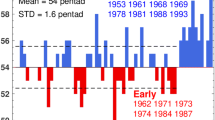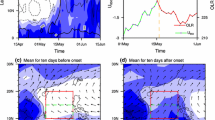Abstract
The circulation pattern corresponding to the strong / weak summer monsoon in the South China Sea (SCS) region and the associated characteristics of the abnormal rainfall in Eastern China have been studied by using the NECP reanalysis data and precipitation data in China. The results show that the climate variations in China caused by the strong / weak summer monsoon are completely different (even in opposite phase). The analyses of atmospheric intraseasonal oscillation (ISO) activity showed that the atmospheric ISO at 850 hPa near the SCS region is strong (weak) corresponding to the strong (weak) SCS summer monsoon. And the analyses of the circulation pattern of the atmospheric ISO showed that the strong / weak SCS summer monsoon circulation (200 hPa and 850 hPa) result mainly from abnormal atmospheric ISO.
This study also reveals that the atmospheric ISO variability in the South China Sea region is usually at opposite phase with one in the Jiang-huai River basin. For example, strong (weak) atmospheric ISO in the SCS region corresponds to the weak (strong) atmospheric ISO in the Jiang-huai River basin. As to the intensity of atmospheric ISO, it is generally exhibits the local exciting characteristics, the longitudinal propagation is weak.
Similar content being viewed by others
References
He **hai, Zu Qiangen, and M. Murakami, 1997: TBB-data-revealed features of Asian-Australian monsoon seasonal transition and Asian summer monsoon establishment. J. Tropical Meteorology, 3, 18–26.
** Zuhui, and Chen Longxun, 1983: Medium-range variation of East Asia summer monsoon system and its relationship with India summer monsoon system. Proceedings of the Symposium on the Summer Monsoon, People’s Press of Yunnan Province, Kunming, 204–217.
Lau, K. M., and S. Yang, 1996: Seasonal Variation, abrupt transition, and intraseasonal variability associated with the Asian summer monsoon in the GLA GCM. J. Climate, 9, 965–985.
Li Chongyin, Chen Yuxiang, Yuan Chongguang, 1989: Important factor cause the El Nino event-the frequent activities of the stronger cold waves in East Asia. Frontiers in Atmospheric Sciences, Allenton Press INC, New York, 156-165.
Li Chongyin, and Zhang Li**, 1999: Summer monsoon activities in the SCS and its impacts. Chinese J. Atmos., Sci., 23, 257–266.
Li Chongyin, 1993: Atmospheric Low-Frequency Oscillation, China Meteorological Press, 310pp (in Chinese).
Li Chongyin, Qu **n, 2000: The large scale atmosphere circulation evolution with summer monsoon onset in the South China Sea. Chinese J. Atmos., Sci., 24, 1–14.
Li Chongyin, and Li Guilong, 1997: Evolution of intraseasonal oscillation over the tropical western Pacific / South China Sea and its effect to the summer precipitation in Southern China. Advances in Atmospheric Sciences, 14, 246–254.
Liu **a, **e An, and Ye Qian, 1998: The climate character of summer monsoon onset over the SCS. J. of Tropical Meteorology, 14, 28–37 (in Chinese).
Tao, S., and L. Chen, 1987: A review of the recent research on the East Asian summer monsoon in China. Monsoon Meteorology, Oxford University Press, 60–92.
Vernekar, A. D., and Y. Ji., 1999: Simulation of the onset and intraseasonal variability of two contrasting summer monsoon. J. Climate, 12, 1707–1725.
WMO, ICSU and UNESCO, 1995: CLIVAR—A Study of the Climate Variability and Predictability, WMO/TD, No. 690.
Xu Yuhong, and Tao Shiyan, 1996: The interannual variability of the East Asian summer monsoon and · the drought and flood in the Changjiang-Huaihe River valleys for the Meiyu period. Study on the Formation Processes of the Disastrous Climate and Its Diagnostics, China Meteorological Press, 31–39 (in Chinese).
Zhang Qingyun, Chen Lieting, and Tao Shiyan, 2000: Definition/ prediction of East Asian monsoon index and atmospheric circulation in Asia. Research and Manufacture of Short Climate Monitor, Prediction and Service Systems, China Meteorological Press, 169–184 (in Chinese).
Zhu, Q., J. He, and P. Wang, 1986: A study of the circulation differences between East Asian and Indian summer monsoon with their interaction. Advances in Atmospheric Sciences., 3, 466–477.
Zhu Qiangen, and Xu Guoqiang, 1999: Features of 1998 SCS summer monsoon LFO with effect on the rainfall in Yangts River basin in 1998. Onset and Evolution of the SCS Monsoon and Its Interaction with the Ocean, China Meteorological Press, 108–111.
Author information
Authors and Affiliations
Additional information
This was supported by National Key Basic Science Program in China (G1998040903) and State Key Project-SCSMEX.
Rights and permissions
About this article
Cite this article
Chongyin, L., Zhenxia, L. & Qingyun, Z. Strong/ weak summer monsoon activity over the South China Sea and atmospheric intraseasonal oscillation. Adv. Atmos. Sci. 18, 1146–1160 (2001). https://doi.org/10.1007/s00376-001-0029-x
Received:
Revised:
Issue Date:
DOI: https://doi.org/10.1007/s00376-001-0029-x




